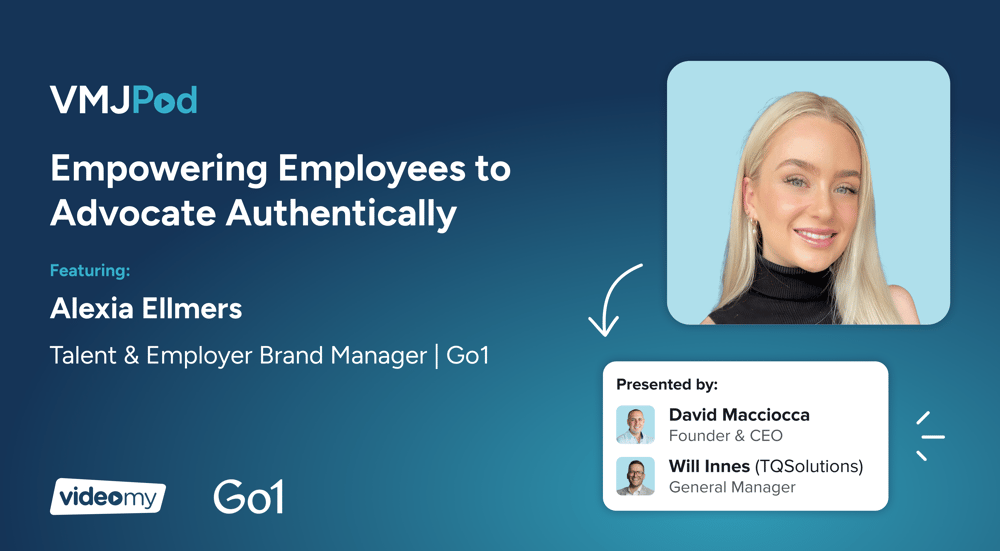When Alexia Ellmers joined Go1, the Brisbane-founded edtech unicorn, she walked into a business in full hypergrowth. The company was expanding globally, hiring fast, and cementing its place as one of Australia’s standout SaaS success stories.
But with growth came a challenge. Outside Australia, few people had heard of Go1.
“When I spoke to candidates in the US or Europe, the main barrier was that they didn’t know who we were,” Alexia recalls. “They were hesitant to leave a great job for a startup they’d never heard of. We didn’t have brand advocacy.”
That gap sparked an idea that would transform Go1’s culture of pride into a movement of authentic advocacy.
From Recruiter to Employer Brand Advocate
At the time, Alexia wasn’t in an employer branding role. She was a recruiter. But she saw the potential of turning Go1’s naturally engaged workforce into its loudest champions.
“Our people were already posting about how proud they were to work here,” she says. “I just thought, what if we built something around that?”
Armed with curiosity and conviction, Alexia pitched her first employee advocacy program, linking it to both culture and commercial outcomes.
“I knew advocacy could reduce agency spend, boost reach, and engage employees,” she explains. “It was a win-win. We could attract better candidates and give our people a chance to build their own personal brand.”
Making the Case and Creating Hype
When the idea was approved, Alexia designed the program to feel exciting, inclusive, and intentional.
Go1 invited employees to apply, creating an exclusive pilot group of advocates. The message was simple: If you want to grow your personal brand, this is your chance.
“We had a huge response,” Alexia says. “People were already proud to work here. They just needed permission and support to start sharing it.”
To kick off, Alexia partnered with LinkedIn, hosting a personal branding launch day that helped participants find their voice online. Each advocate received a welcome pack, a Slack community for sharing ideas, and weekly content prompts.
“We didn’t just say, ‘Go post something,’” she laughs. “We made it easy. Ready-made prompts, simple templates, and a space to share wins and ideas.”
Balancing Control and Authenticity
Like any advocacy program, the balance between creative freedom and brand safety was critical. Go1 took a light-touch approach, providing enough guidance to build confidence but never so much that it stifled authenticity.
“We looped in our social media manager for a brand guidelines session, but we didn’t want to control it to the point people were scared to post,” Alexia says. “The best content was personal. Stories about lessons learned or small wins. That’s what people engage with.”
Her golden rule for participants was simple:
“If you’re unsure about posting something, run it past us first. And if you feel weird about it, don’t post it. That’s usually your gut telling you it’s not authentic.”
Keeping Momentum with Gamification and Community
To keep engagement high, Alexia introduced friendly competition and regular recognition.
“We ran a small comp, a $50 voucher for the best post each fortnight,” she says. “It was never about the prize. It was about celebrating creativity and consistency.”
The Slack channel became a source of connection and confidence. Each time someone shared a post, the group would like and comment, giving everyone an instant boost of visibility.
“People’s biggest fear is posting and getting no likes,” Alexia says. “So we made sure no one posted into a void. Everyone had each other’s back.”
Running Advocacy in Sprints
One of Alexia’s biggest learnings came after the initial success. Advocacy isn’t meant to run forever.
“It’s a lot of energy to sustain,” she explains. “I realised advocacy works best in sprints, six-month campaigns tied to business goals. It shouldn’t be an always-on program.”
That timing instinct proved crucial when Go1 faced broader industry headwinds.
“We went through mergers and a period of layoffs, and that’s not the right time to run advocacy,” she says. “When employees are going through change, it’s time to turn inward, not amplify outward.”
Instead, her team pivoted focus to internal storytelling, refreshing the EVP, rebuilding culture, and strengthening identity across newly merged teams.
“Employer branding is cyclical,” she says. “You activate when the time’s right, then pause, listen, and rebuild.”
Results and What’s Next
Go1’s pilot delivered measurable impact, boosting reach, engagement, and employer brand visibility across new regions.
“The content shared by employees reached 500% more people than company posts,” Alexia says. “It proved the power of advocacy.”
Today, as Go1 shifts focus toward talent density — hiring fewer but higher-impact roles — advocacy remains central to its attraction and retention strategy.
“We’re always looking for the 10x people who move the needle,” Alexia says. “And the best way to find them is through the voices of the people already here.”
Alexia’s Key Lessons for Advocacy Success
-
Start small and prove value fast. Pilot with a select group before scaling.
-
Make it easy to participate. Give prompts, tools, and structure.
-
Balance guidance with freedom. Empower authenticity over polish.
-
Run in sprints. Tie programs to business goals, then pause and reset.
-
Time it right. Don’t launch during internal turbulence, focus inward first.
-
Let humans lead. Real stories always outperform brand statements.
🎥 Watch the Episode
🎧 Listen to the Podcast
.png?width=200&height=50&name=Untitled%20design%20(21).png)






